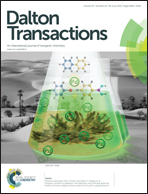Labile coordination approach for the modulation of the electronic properties of ruthenium(ii) and iridium(iii) complexes within an “N-heterocyclic carbene (NHC)–pyridyl” dynamic platform†
Abstract
Modulating the functionality of a synthetic transition metal complex by external stimuli is highly important for designing switchable systems. One prerequisite for achieving such dynamic activity is to generate molecular systems with in situ controllable electronic properties. To achieve dynamic control of the electronic properties, here we report the synthesis of two new N-heterocyclic carbene (NHC)–pyridyl IrIII/IrIII (3) and RuII/RuII (4) bimetallic complexes. These complexes include a latent stimuli-responsive labile site. This is utilized successfully for the on-demand, real-time modulation of the electronic properties of the systems in a reversible manner using external agents, as probed by spectroscopic and electrochemical techniques. These results display promising scope in the domain of transition metal–NHC chemistry, which can guide us in developing future smart organometallic systems.


 Please wait while we load your content...
Please wait while we load your content...